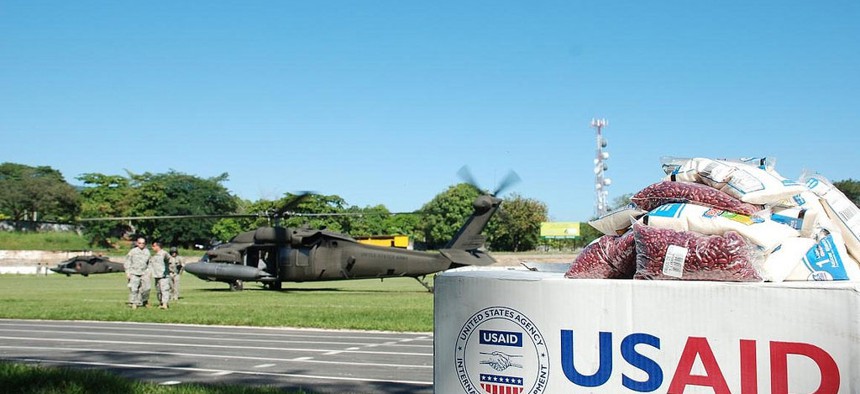
Two UH-60 helicopters prepare to pick up supplies en route to Ostuma, El Salvador, as part of a disaster relief effort after heavy rainstorms in the country 1st Lt. Jen Richard, U.S. Air Force
Why Nations Are Right To Ban USAID
Using the misfortune of less developed countries as a cover to advance U.S. interests compromises the credibility of all foreign aid. By Mark Varga
What is USAID good for? Revelations that the agency—which stands for the US Agency for International Development and offers humanitarian assistance around the world—funneled money to Cuba to start a social media program bent on spreading political content and eventually overthrowing Fidel Castro sent shockwaves across the world. This “digital Bay of Pigs” is just the latest installment in the never-ending series of revelations that have compromised America’s desired image as a good and just hegemon. In truth, this is simply business as usual for USAID and the swathe of related philanthropic foundations and aid donors that have been used as vehicles for US foreign policy.
Rather than gasping in surprise at USAID’s covert exploits, it is important to take a step back from the media brouhaha surrounding the organization and look at the bigger picture. Indeed, on closer scrutiny, several patterns emerge underneath the business of giving money away for supposedly high-minded causes. Saving the world and alleviating world poverty is just one such motive. Power in the form of promoting a Western-backed design on what is right is another one. USAID for one makes no secret of this mission, stating on its website that its purpose is to “further America’s interest while improving lives in the developing world.”
This is just part of the picture. In fact, under the generic title of philanthropic organizations, one can find a plethora of governmental agencies, foundations, charities, friendship societies, and NGOs. In the US, many are financed by both sides of the political divide and are powered to achieve political goals. Indeed, ever since the 1960s, when conservative foundations began giving grants to key institutions, philanthropic organizations have been closely connected to the public policy cycle
How to keep friends
Even before the Citizens United Supreme Court decision, strategic grant making has been used extensively to notch progress toward both internal and external political goals. For the better part of the Cold War, the US has maintained geopolitical influence in the world by financing friendly regimes and pushing for like-minded reforms. Egypt for instance has swallowed some $71 billion of aid since 1946. Pakistan was propped up to the tune of $67 billion.
After Kennedy created USAID in 1961, the agency has been the proving ground of US foreign assistance objectives, used to project US soft power on a global scale. In a landmark Harvard paper from 2006, it was proven that countries rotating onto the UN Security Council received on average 59% more aid. As soon as their term ended, aid would fall to historic lows. In a related study from 1999, T.Y.Wang from Illinois State University found that UN voting patterns on vital issues to American interests were successfully swayed through the practice of aid giving, rewarding compliance and punishing political defiance.
To maintain its position in the world, the US has to dole out wads of cash to political regimes around the world. More revelations about the way USAID operates were brought to light in the form of a multimillion-dollar “incentive fund’”disbursed to foreign governments to push through reforms deemed by Washington as being priorities. The US government gave $15 million directly to Afghan officials in exchange for passing a law on violence against women. Another $15 million was given last year for implementing budget changes.
How to make enemies
Such moral decrepitude has come under fire from multiple countries that have hardened their stance towards aid organizations in general. In a show of force, Russia passed a law forcing foreign NGOs to register as “foreign agents.” Afterwards, it ordered USAID out of Russia over allegations of undermining the government. It may have seemed as yet another example of Russian authoritarianism, but Business Insider reported the leaking of 60 MB of emails between US agencies and opposition groups in Russia, showing that the US was paying these opposition groups and backing anti-Putin protests in Moscow.
Russia was not the only country to expel USAID from its territory. From places like Eritrea, all the way to Ecuador, Venezuela, Cuba and Bolivia, the American agency either had its offices closed by the respective governments or is in the process of shutting down. These countries have expressed fears over USAID’s destabilizing influence. In a now famous case, a Cuban-based American contractor Alan Gross was sentenced to 15 years in prison for “acts against the integrity of the state.” He had been covertly outfitting the Jewish community with telecommunications equipment illegal in Cuba.
From friendly aid to friendly fire
What does all this mean? Simply put, political power is no longer projected using the mechanisms of yore, but has found new vehicles in the form of foreign aid. Though foreign leaders who decry the political motivations of “humanitarian” NGOs come across as paranoid, a cursory glance at history suggests otherwise.
It is woeful that laudable goals like “promoting democracy” or “strengthening civil society” are used by the United States to push for regime change according to their interests. Using the misfortune of less developed countries as a cover to advance specific foreign policy agendas compromises the credibility and legitimacy of all foreign aid. Regardless of content, Washington’s dabbling in the internal affairs of other countries with such intensity is morally wrong and has endlessly backfired.
In a world of inconsequential “red lines” and “costs,” Washington is on the verge of losing its most precious asset: its soft power. When political posturing is not involved, aid agencies help and provide the critical difference between life and death for countless people across the developing world. It should have stayed like that.
NEXT STORY: What Hawks and Doves Both Miss on the Asia Pivot




